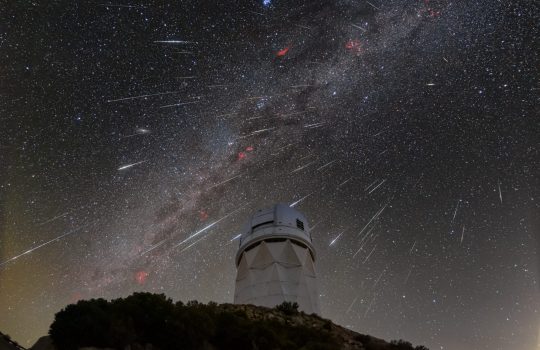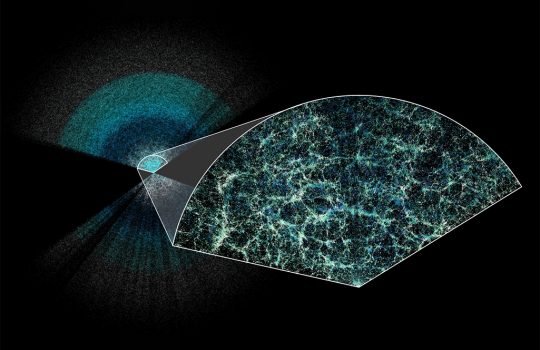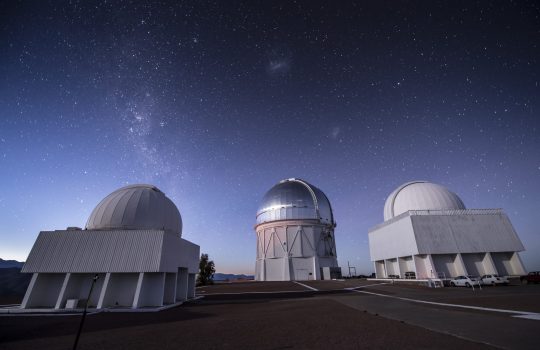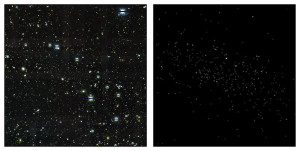
These two images allow you to see how difficult it is to spot these dwarf galaxy candidates in the Dark Energy Camera’s images. The first image is a snapshot of DES J0335.6-5403, a celestial object found with the Dark Energy Camera. It is the most likely of the newly discovered candidates to be a galaxy, according to DES scientists. This object sits roughly 100,000 light-years from Earth, and contains very few stars – only about 300 could be detected with DES data. The second image shows the detectable stars that likely belong to this object, with all other visible matter blacked out. Dwarf satellite galaxies are so faint that it takes an extremely sensitive instrument like the Dark Energy Camera to find them. More analysis is required to confirm if any of the newly discovered objects are in fact galaxies. Image: Fermilab/Dark Energy Survey
Scientists on two continents have independently discovered a set of celestial objects that seem to belong to the rare category of dwarf satellite galaxies orbiting our home galaxy, the Milky Way.
Dwarf galaxies are the smallest known galaxies, and they could hold the key to understanding dark matter and the process by which larger galaxies form.
A team of researchers with the Dark Energy Survey, headquartered at the U.S. Department of Energy’s Fermi National Accelerator Laboratory, and an independent group from the University of Cambridge jointly announced their findings today. Both teams used data taken during the first year of the Dark Energy Survey, all of which is publicly available, to carry out their analysis.
“The large dark matter content of Milky Way satellite galaxies makes this a significant result for both astronomy and physics,” said Alex Drlica-Wagner of Fermilab, one of the leaders of the Dark Energy Survey analysis.
Satellite galaxies are small celestial objects that orbit larger galaxies, such as our own Milky Way. Dwarf galaxies can be found with fewer than 100 stars and are remarkably faint and difficult to spot. (By contrast, the Milky Way, an average-sized galaxy, contains billions of stars.)
These newly discovered objects are a billion times dimmer than the Milky Way and a million times less massive. The closest of them is about 100,000 light-years away.
“The discovery of so many satellites in such a small area of the sky was completely unexpected,” said Cambridge’s Institute of Astronomy’s Sergey Koposov, the Cambridge study’s lead author. “I could not believe my eyes.”
Scientists have previously found more than two dozen of these satellite galaxies around our Milky Way. About half of them were discovered in 2005 and 2006 by the Sloan Digital Sky Survey, the precursor to the Dark Energy Survey. After that initial explosion of discoveries, the rate fell to a trickle and dropped off entirely over the past five years.
The Dark Energy Survey is looking at a new portion of the southern hemisphere, covering a different area of sky than the Sloan Digital Sky Survey. The galaxies announced today were discovered in a search of only the first of the planned five years of Dark Energy Survey data, covering roughly one-third of the portion of sky that DES will study. Scientists expect that the full Dark Energy Survey will find up to 30 of these satellite galaxies within its area of study.
While more analysis is required to confirm any of the observed celestial objects as satellite galaxies, researchers note their size, low surface brightness and significant distance from the center of the Milky Way as evidence that they are excellent candidates. Further tests are ongoing, and data collected during the second year of the Dark Energy Survey could yield more of these potential dwarf galaxies to study.
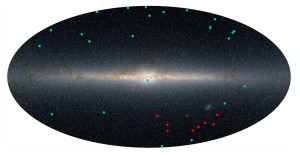
This illustration maps out the previously discovered dwarf satellite galaxies (in blue) and the newly discovered candidates (in red) as they sit outside the Milky Way. Image: Yao-Yuan Mao, Ralf Kaehler, Risa Wechsler (KIPAC/SLAC).
Atlas image obtained as part of the Two Micron All Sky Survey (2MASS), a joint project of the University of Massachusetts and the Infrared Processing and Analysis Center/California Institute of Technology, funded by the National Aeronautics and Space Administration and the National Science Foundation.
Newly discovered galaxies would also present scientists with more opportunities to search for signatures of dark matter. Dwarf satellite galaxies are dark matter-dominated, meaning they have much more mass in unseen matter than in stars. The nature of this dark matter remains unknown but might consist of particles that annihilate each other and release gamma rays. Because dwarf galaxies do not host other gamma ray sources, they make ideal laboratories to search for signs of dark matter annihilation. Scientists are confident that further study of these objects will lead to even more sensitive searches for dark matter.
In a separate result also announced today, the Large Area Telescope Collaboration for NASA’s Fermi Gamma-Ray Telescope mission reported that they did not see any significant excess of gamma ray emission associated with the new Dark Energy Survey objects. This result demonstrates that new discoveries from optical telescopes can be quickly translated into tests of fundamental physics.
“We did not detect significant emission with the LAT, but the dwarf galaxies that DES has and will discover are extremely important targets for the dark matter search,” said Peter Michelson, spokesperson for the LAT collaboration. “If not leading to an identification of particle dark matter, they will certainly be useful to constrain its properties.”
The Dark Energy Survey is a five-year effort to photograph a large portion of the southern sky in unprecedented detail. Its primary instrument is the Dark Energy Camera, which – at 570 megapixels – is the most powerful digital camera in the world, able to see galaxies up to 8 billion light-years from Earth. Built and tested at Fermilab, the camera is now mounted on the 4-meter Victor M. Blanco telescope at the Cerro Tololo Inter-American Observatory in the Andes Mountains in Chile.
The survey’s five-year mission is to discover clues about the nature of dark energy, the mysterious force that makes up about 70 percent of all matter and energy in the universe. Scientists believe that dark energy may be the key to understanding why the expansion of the universe is accelerating.
“The Dark Energy Camera is a perfect instrument for discovering small satellite galaxies,” said Keith Bechtol of the Kavli Institute for Cosmological Physics at the University of Chicago, who helped lead the Dark Energy Survey analysis. “It has a very large field of view to quickly map the sky and great sensitivity, enabling us to look at very faint stars. These results show just how powerful the camera is and how significant the data it collects will be for many years to come.”
The Dark Energy Survey analysis is available here. The University of Cambridge analysis is available here.
The Dark Energy Survey is a collaboration of more than 300 scientists from 25 institutions in six countries. For more information about the survey, please visit the experiment’s website.
Funding for the DES Projects has been provided by the U.S. Department of Energy, the U.S. National Science Foundation, the Ministry of Science and Education of Spain, the Science and Technology Facilities Council of the United Kingdom, the Higher Education Funding Council for England, the National Center for Supercomputing Applications at the University of Illinois at Urbana-Champaign, the Kavli Institute of Cosmological Physics at the University of Chicago, Financiadora de Estudos e Projetos, Fundação Carlos Chagas Filho de Amparo à Pesquisa do Estado do Rio de Janeiro, Conselho Nacional de Desenvolvimento Científico e Tecnológico and the Ministério da Ciência e Tecnologia, the Deutsche Forschungsgemeinschaft and the collaborating institutions in the Dark Energy Survey. The DES participants from Spanish institutions are partially supported by MINECO under grants AYA2012-39559, ESP2013-48274, FPA2013-47986 and Centro de Excelencia Severo Ochoa SEV-2012-0234, some of which include ERDF funds from the European Union.
Fermilab is America’s premier national laboratory for particle physics and accelerator research. A U.S. Department of Energy Office of Science laboratory, Fermilab is located near Chicago, Illinois, and operated under contract by the Fermi Research Alliance, LLC. Visit Fermilab’s website at www.fnal.gov and follow us on Twitter at @Fermilab.
The DOE Office of Science is the single largest supporter of basic research in the physical sciences in the United States and is working to address some of the most pressing challenges of our time. For more information, please visit science.energy.gov .
The mission of the University of Cambridge is to contribute to society through the pursuit of education, learning and research at the highest international levels of excellence. To date, 90 affiliates of the university have won the Nobel Prize. Founded in 1209, the university comprises 31 autonomous colleges, which admit undergraduates and provide small-group tuition, and 150 departments, faculties and institutions. Cambridge is a global university. Its 19,000 student body includes 3,700 international students from 120 countries. Cambridge researchers collaborate with colleagues worldwide, and the university has established larger-scale partnerships in Asia, Africa and America. The university sits at the heart of one of the world’s largest technology clusters. The ‘Cambridge Phenomenon’ has created 1,500 hi-tech companies, 14 of them valued at over US$1 billion and two at over US$10 billion. Cambridge promotes the interface between academia and business and has a global reputation for innovation. www.cam.ac.uk .

